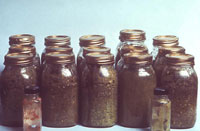General Information
Recommendations to preserve food at home are based on science. This process is not the place to be creative and make up your own recipes. Doing this can lead to foodborne illness. While the practice of preserving food has existed for thousands of years, the methods have evolved to keep up with today's food safety issues.
The Science Behind Home Canning
- Principles of Home Canning
- How Canning Preserves Foods
- Cost of Preserving and Storing Food
- How-to Guide to Water Bath Canning and Steam Canning - Kansas State University
- Guía Práctica para Envasar con Baño de Agua y Envasar al Vapor - Kansas State University
- How-to Guide to Pressure Canning - Kansas State University
- Guía Práctica para Envasar a Presión - Kansas State University
- What's Your Elevation? - Kansas State University
- ¿Cuál es su altitud? - Kansas State University
- 10 Tips for Safe Home-Canned Food - Kansas State University
- 10 Consejos para Enlatados Caseros Seguros - Kansas State University
- Approximate Yields for Canning
- Carolina Canning Tips - Clemson University
Old Food Preservation Practices No Longer Recommended
- Why old time recipes can't be used for canning - Clemson University
- Say "No" to old pickle recipes - Clemson University
- Canning controversies: No to home canning dairy products - Clemson University
- Avoid Open Kettle or Oven Canning - Penn State University
- Jars with wire bails and glass caps - University of Georgia
- Cakes and Breads in Jars - Are They Safe? - Clemson University
- Using paraffin wax on sweet spreads - University of Georgia
- Canning in Pressure Cookers - University of Georgia
- Canning Pumpkin Butter and Mashed or Pureed Squash - University of Georgia
- Canning Chocolate Sauce Unsafe - University of Georgia


